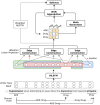Adverse drug events and medication relation extraction in electronic health records with ensemble deep learning methods
- PMID: 31390003
- PMCID: PMC6913215
- DOI: 10.1093/jamia/ocz101
Adverse drug events and medication relation extraction in electronic health records with ensemble deep learning methods
Abstract
Objective: Identification of drugs, associated medication entities, and interactions among them are crucial to prevent unwanted effects of drug therapy, known as adverse drug events. This article describes our participation to the n2c2 shared-task in extracting relations between medication-related entities in electronic health records.
Materials and methods: We proposed an ensemble approach for relation extraction and classification between drugs and medication-related entities. We incorporated state-of-the-art named-entity recognition (NER) models based on bidirectional long short-term memory (BiLSTM) networks and conditional random fields (CRF) for end-to-end extraction. We additionally developed separate models for intra- and inter-sentence relation extraction and combined them using an ensemble method. The intra-sentence models rely on bidirectional long short-term memory networks and attention mechanisms and are able to capture dependencies between multiple related pairs in the same sentence. For the inter-sentence relations, we adopted a neural architecture that utilizes the Transformer network to improve performance in longer sequences.
Results: Our team ranked third with a micro-averaged F1 score of 94.72% and 87.65% for relation and end-to-end relation extraction, respectively (Tracks 2 and 3). Our ensemble effectively takes advantages from our proposed models. Analysis of the reported results indicated that our proposed approach is more generalizable than the top-performing system, which employs additional training data- and corpus-driven processing techniques.
Conclusions: We proposed a relation extraction system to identify relations between drugs and medication-related entities. The proposed approach is independent of external syntactic tools. Analysis showed that by using latent Drug-Drug interactions we were able to significantly improve the performance of non-Drug-Drug pairs in EHRs.
Keywords: adverse drug events; electronic health records; ensemble methods; neural networks; relation extraction.
© The Author(s) 2019. Published by Oxford University Press on behalf of the American Medical Informatics Association.
Figures





References
-
- Bates DW, Cullen DJ, Laird N.. Incidence of adverse drug events and potential adverse drug events: implications for prevention. JAMA 1995; 274 (1): 29–34. - PubMed
-
- Dasgupta T, Naskar A, Dey L. Exploring linguistic and graph based features for the automatic classification and extraction of adverse drug effects. In: Proceedings of CICLing; 2017: 463–74.
Publication types
MeSH terms
Grants and funding
LinkOut - more resources
Full Text Sources
Medical

